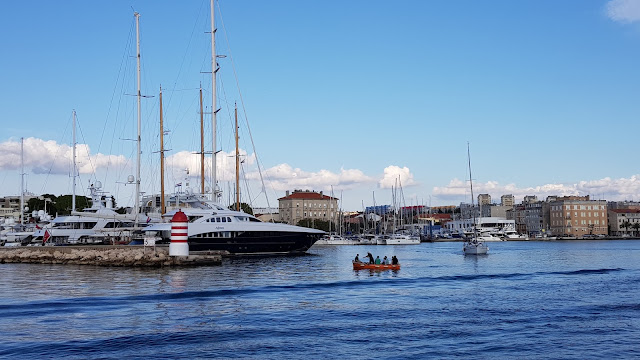23 - 24 September 2017
The last day of my entire trip was spent in Krka National Park and Zadar. I stayed overnight at Sibenik and decided to visit the UNESCO listed - Cathedral of Saint James the next morning before moving to Krka National Park.
The Cathedral of St James in Šibenik (1431-1535), on the Dalmatian coast, bears witness to the considerable exchanges in the field of monumental arts between Northern Italy, Dalmatia and Tuscany in the 15th and 16th centuries. The three architects who succeeded one another in the construction of the Cathedral - Francesco di Giacomo, Georgius Mathei Dalmaticus and Niccolò di Giovanni Fiorentino - developed a structure built entirely from stone and using unique construction techniques for the vaulting and the dome of the Cathedral. The form and the decorative elements of the Cathedral, such as a remarkable frieze decorated with 71 sculptured faces of men, women, and children, also illustrate the successful fusion of Gothic and Renaissance art. Photography is not allwed in the church and here I put a picture of the interior downloaded from internet.
Krka National Park offers incredible walkways to take you around, over and alongside the water with the most wonderful views. There is a nice circular path at Skradinski Buk falls that can be easily walked in 60 minutes. This place definitely well worths a vist. There water is so clear and green. The entrance was 110kuna per adult.
https://www.tripadvisor.com.sg/Restaurant_Review-g295374-d3479071-Reviews-Sabunjar-Zadar_Zadar_County_Dalmatia.html
I wanted to try Peka, which is a Dalmation dish. So what is a Peka? A Peka is a baked dish with meat and vegetables made in a pot or a tray, the pot is put into the embers of a fireplace, in many houses here in Dalmatia, especially on the country side, you have a special place in the barn or at the ground floor of the house for preparing the Peka.
I ordered veal peka (50 kuna) and fried squids. The veal meat was tender and the potatoes were nice too, rather oily though. The price was reasonable for skillfully prepared Croatian cuisine. Their service was also very professional. At times, the waiter dropped by at my table and asked if everything was fine. I even exchanged our Euro to Kunas with them.
I moved on to Zadar. I parked my car at housing area near Barka Bar & Caffe and took the barkajoli to the city center. For over 800 years these gondoliers have been connecting the two ends of Zadar´s harbour with their small rowboats in any weather conditions, and in so doing have saved the time of their faithful passengers. This tradition has been passed on from father to son for centuries and has survived despite the challenges of modern times. Each trip costs 5 kunas.
The Greeting to the Sun consists of three hundred multi-layered glass plates placed on the same level with the stone-paved waterfront in the shape of a 22-meter diameter circle. Under the glass conduction plates there are photo-voltage solar modules through which symbolic communication with nature is made, with the aim to communicate with light, just like the Sea Organs do with sound.
Simultaneously with the most beautiful sunset in the world, the lighting elements installed in a circle turn on, and, following a particularly programmed scenario, they produce a marvelous, exceptionally impressive show of light in the rhythm of the waves and the sounds of the Sea organs. I was not at the correct timing to see the light as I arrived at noon.
Sea Organ is situated on the western end of Zadar´s Riva, and can be observed as a differently shaped part of the coast which consists of several stairs that descend into the sea. The organ looks like a series of broad steps leading down into the water, but there´s actually very clever engineering hiding under the surface.The lower steps allow water and air to flow in. That water and air is then funneled into resonant chambers under the steps, and pushed out through the channels on the upper stairs, seen here. These cause the undulating, chime-like notes to be produced. Because the sea is always shifting and changing, the sea organ never sounds exactly the same twice. Each sound you hear is completely unique.
Most striking is the decorative column marking the western side of the forum. Notice the chains still visible on the column. During the Middle Ages it was the "pillar of shame" used to punish evildoers.
Continuing on the western side of the Forum, you come to the remains of the Capitolium which was an important temple consecrated to Jupiter, Juno and Minerva. Take a moment to examine the beautifully decorated fragments of capitals on display around the square.
Based on reviews, I decided to try the gelato in Gelateria Eva. Small size cup was only 12kn. It was surely delicious. I ordered one hazelnut, the taste was full and the other one either raspberries or strawberries which was fruity and sour.
After a short trip at Zadar, I drove back to Zagreb and stayed an overnight here to catch morning flight the next day back to home. The trip lasted for 17 days, I visited 3 countries, 14 cities/towns, 7 main UNESCO sites (could have done another two), 5 national parks, drove 9296km on the opposite side and collected 11 immigration stamps.












































No comments:
Post a Comment